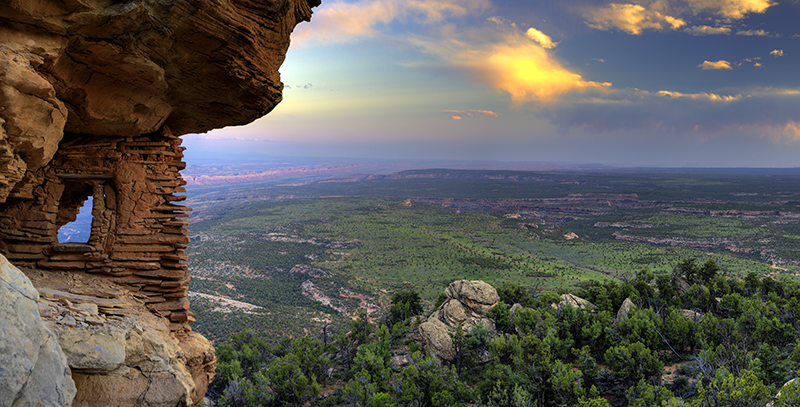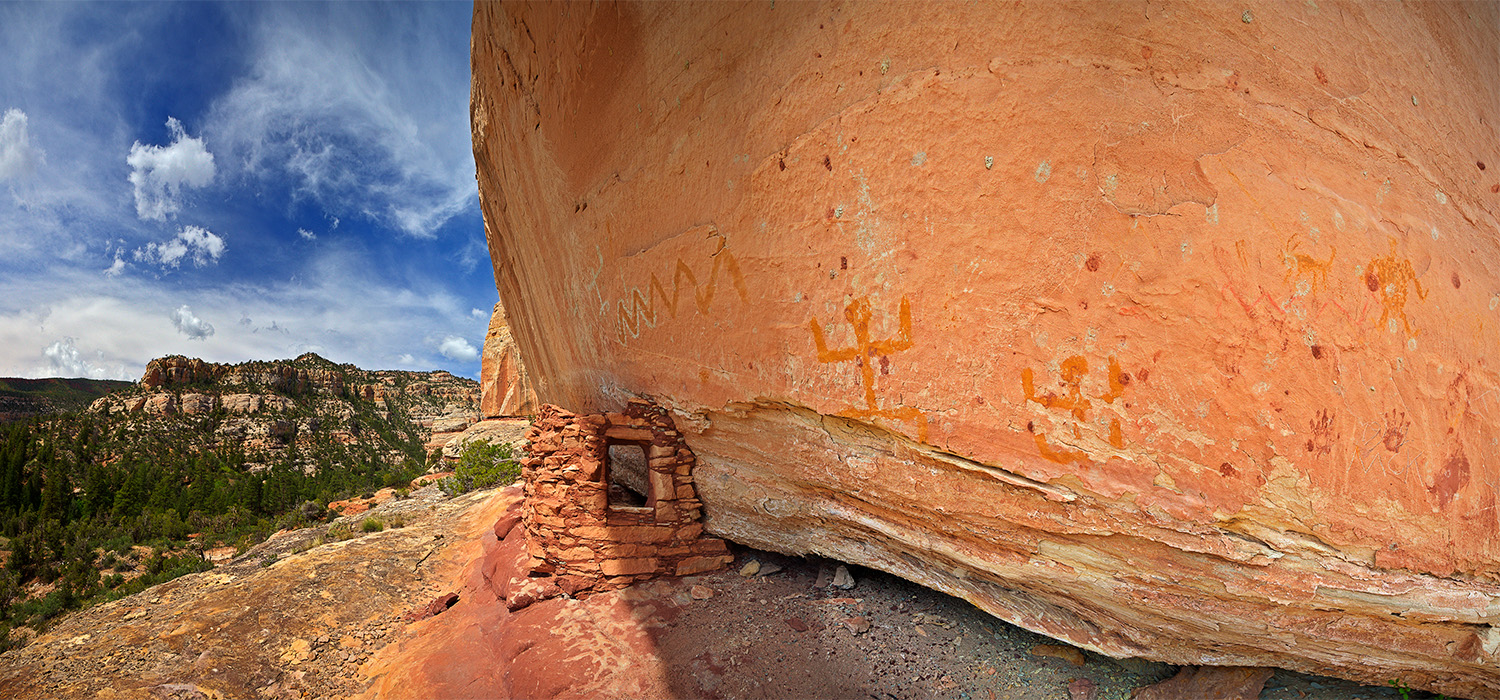
 by Talia Boyd, Cultural Landscapes Manager
by Talia Boyd, Cultural Landscapes Manager
This blog is distilled from the Native Perspectives virtual series held in partnership with Grand Staircase Escalante Partners in 2020. Hear from Native experts on a range of issues related to public lands and tribal preservation. Explore the recordings ›
Contrary to history textbooks, America was never “empty space.” European settlers were not the first residents of our country. Native peoples have existed here since the beginning of time, according to our cosmologies. As white colonists moved West to stake their claim on tribal territories, they forced out Native populations.
The idea of “owning” land is a foreign concept for Native peoples. The land is sentient. It encompasses many life forms and spaces. It holds immense energy. From a Native perspective one cannot “own” land, yet one may live with the land. Our regenerative relationships to land are based on generations of deep interconnectedness that have been taught through our cosmologies, ceremonies, and languages. Native peoples acknowledge that these on-going connections require responsibilities to the natural world. We provide offerings and prayers to the land for its healing. Traditional teachings instruct us to maintain deep respect for land, life, and our four-legged and winged relatives — all our relations.
Below, three Native experts weigh in on the history of tribal lands, sovereignty, and what it means to own land.
In the 1800s, most reservation boundaries were established by treaties. These tribal lands were held in trust by the federal government, meaning the government owned the titles and had the final say on the lands, while the tribes held the “beneficial use,” (i.e. they could use them).
At the turn of the century, the government changed its reservation policy with the General Allotment Act of 1887, or the Dawes Act. This law aimed to force Native Americans into mainstream culture. It authorized the government to break up American Indian treaty lands into small parcels granted to individual tribal members rather than tribes. Only Native Americans who enrolled with the Bureau of Indian Affairs could receive their allotments. The remaining treaty lands were deemed surplus and sold to white settlers, effectively stripping over 90 million acres of tribal land from Native Americans.
The underlying intention, says Cris Stainbrook, a member of the Oglala Lakota Nation and president of the Indian Land Tenure Foundation, was “to have the General Allotment Act as a mighty pulverizing engine to break up the tribal mass.”
More than a hundred years later, this law has had lasting consequences in Indian country. Stainbrook explains that the Dawes Act didn’t have a good methodology for dividing the property among the heirs of the deceased allottee. The title would divide, but not the land. Over generations, this problem has compounded.
“We have properties now with as many as eight or 10,000 owners on them…For Indian people to manage that, imagine sitting down at one of the feast days and you’ve got 2,000 of your closest relatives. And you’re going to talk about managing 160 acres somewhere. I mean, not an easy conversation.”
Stainbrook would like to see tribes push for the fundamental jurisdiction of their nations.
“They wanted us to be farmers and ranchers on land that wasn’t going to support a farm or ranch. And we need to break that and move on and regain our rights on our land.”
The federal government used the Dawes Act to assimilate Native Americans and try to get them to farm and ranch like white homesteaders.
Dr. Kelsey Dayle John, assistant professor of gender, women’s, and American Indian studies at the University of Arizona, points to the grazing system in place today as a narrative that started with colonial contact. Indigenous lands were taken as public lands, and federal policies like the Taylor Grazing Act have regulated their use for ranching and private profit.
But the concept of leased property is not part of Indigenous worldviews.
“There’s lots of Native American ranchers, right? We were always doing agriculture. We just weren’t doing it in the way that the [federal policies] protected and provided for.”
She continues, “We’ve always been learning from animals. We’ve always been learning from the land. We’ve always been in communication.”
What about culturally significant lands outside of reservations? Traditional cultural properties are a designation under the National Historic Preservation Act of 1962 that preserve tribal properties or historic sites that aren’t necessarily within a reservation.
“If the traditional cultural property is recognized and it is placed on the registry, it basically brings to bear the full regulatory practices and legal practices of the federal government over these locations,” explains Dr. Joseph Brewer, a member of the Cherokee Nation of Oklahoma and affiliate of the Ogalala Lakota Nation of Pine Ridge, South Dakota, and associate professor and director of Indigenous studies at the University of Kansas.
The designation also requires federal agencies, like the National Park Service, Fish and Wildlife Service, etc., to consult with tribes as equal entities.
“The idea of consultation and the idea of co-management is essentially two sovereigns coming together to manage the space on equal footing,” Brewer says.
Treaties also have granted some tribes rights to hunt, fish, and gather on lands outside of their reservation boundaries.
“This idea of traditional homelands expands much farther than the reservation boundaries that you see on a present-day map of the United States today,” Brewer explains.
Beyond traditional cultural property designations, there are several federal policies that tribes can use to gain protective status over sacred places, cultural sites, and traditional tribal homelands. According to Brewer, the ultimate goal is “to get Indian lands in Indian hands.”
 Joseph P. Brewer II, Cherokee and Oglala Lakota, is the associate professor of environmental studies and director of the Indigenous Studies Program at the University of Kansas. He works with Indigenous peoples on issues related to natural resources management and stewardship, energy sovereignty and self-determination, the Federally-Recognized Tribes Extension Program, and land tenure.
Joseph P. Brewer II, Cherokee and Oglala Lakota, is the associate professor of environmental studies and director of the Indigenous Studies Program at the University of Kansas. He works with Indigenous peoples on issues related to natural resources management and stewardship, energy sovereignty and self-determination, the Federally-Recognized Tribes Extension Program, and land tenure.
 Kelsey Dayle John, Diné, is an assistant professor of gender and women's and American Indian studies at the University of Arizona. Her work is on horse-human relationships and creating educational and research spaces that center nonhuman knowledges. She also works on Indigenous methodologies, Indigenous feminisms, and organizes an annual horse conference on the Navajo Nation.
Kelsey Dayle John, Diné, is an assistant professor of gender and women's and American Indian studies at the University of Arizona. Her work is on horse-human relationships and creating educational and research spaces that center nonhuman knowledges. She also works on Indigenous methodologies, Indigenous feminisms, and organizes an annual horse conference on the Navajo Nation.
 Cris Stainbrook, Lakota, is president of the Indian Land Tenture Foundation in Minnesota. The Foundation has distributed nearly $50 million in grants, contracts, and loans to projects throughout Indian country. Previously, he was with Northwest Area Foundation, where he managed programs in sustainable development, natural resource management, economic development, and basic human needs.
Cris Stainbrook, Lakota, is president of the Indian Land Tenture Foundation in Minnesota. The Foundation has distributed nearly $50 million in grants, contracts, and loans to projects throughout Indian country. Previously, he was with Northwest Area Foundation, where he managed programs in sustainable development, natural resource management, economic development, and basic human needs.

Cultural landscapes are full of stories, artifacts, and resources to appreciate. Here's how ›
80% of Arizona voters support Baaj Nwaavjo I'tah Kukveni National Monument, according to a new poll.
Read MoreUtah voters strongly support national monuments in general, and Bears Ears and Grand Staircase-Escalante in particular, a new poll shows.
Read MoreA small victory in the legal case challenging Daneros uranium mine, near Bears Ears National Monument.
Read More